The Earls of Kent
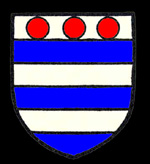
The de Grey coat of arms
The title Earl of Kent was held by up to seven different families before the de Greys and by one family afterwards. The seven previous creations were:
- Godwin, Earl of Wessex was created Earl of Kent in 1020. He died in 1053 and was succeeded as earl by his son Leofwine who died alongside his brother King Harold II at Hastings in 1066 fighting against the Norman usurper William (1066-1087).
- William the Conqueror's half-brother Odo, Bishop of Bayeux was created Earl of Kent in 1067 but forfeited his title in 1082 when he fell out of favour with the king. He was restored on William's deathbed but again forfeited the title in 1088 for backing Robert Curthose as king rather than the successful claimant William II Rufus (1087-1100).
- William de Ipres (Ypres in modern Belgium) may have been created Earl of Kent by King Stephen (1135-1154) as chroniclers described him as possessing the county. He was one of Stephen's military commanders during the civil war against the Queen Empress Matilda, mother of the later Henry II (1154-1189). He died in 1165.
- In 1227 Hubert de Burgh who had risen to be Chief Justiciar under King John (1199-1216) was created Earl of Kent by Henry III (1216-1272) for whom he had acted as regent from 1219. He died in 1243 and left three daughters but no son.
- In 1321 Edmund of Woodstock, a son of King Edward I (1272-1307) was created Earl of Kent by his half-brother King Edward II (1307-1327). He supported Edward in his struggles to retain his crown and paid the price, being executed on 19th March 1330 by Roger Mortimer, the lover of Edward II's wife, Queen Isabella, and regent for her son Edward III (1327-1377), then just seventeen. Woodstock died aged twenty eight. The charge of treason against Edmund was reversed by Edward III in 1331 and Edmund's son, another Edmund succeeded him. He died in 1333 and was succeeded by his brother John, who died in 1352. John's successor was the husband of his sister Joan, later dubbed the Fair Maid of Kent, who later married Edward III's heir Edward the Black Prince, who died before his father. Joan's son was the future Richard II (1377-1399).
- The sixth line of Earls of Kent began with Thomas Holland, who married Joan, the Fair Maid of Kent secretly when she was just twelve. He became Earl of Kent in 1352 on the death of John and in the right of his wife Joan and was never, thus, earl in his own right. He died in 1360 and was succeeded by this son Thomas, who held the earldom in the right of his mother until 1381 when he was created Earl of Kent in his own right. His mother died in 1385 and he died in 1397 and was succeeded by his son Thomas who was created Duke of Surrey for his support of Richard II in the same year he succeeded as Earl of Kent. Richard II was deposed by the usurper Henry IV (1399-1413) in 1399 and Kent rebelled in an attempt to free the imprisoned Richard. He failed and was executed in 1400. Despite this his brother Edmund was allowed to succeed him as Earl of Kent. He died in battle of Île-de-Bréhat in 1408 with no legitimate heir.
- William Nevill was the second son of the 1st Earl of Westmorland. He served as a commander on the Scottish border and in France under King Henry VI (1422-1461 and 1470-1471). He was captured by the French in 1449 and not released until 1453. He fought on the Lancastrian side at the First Battle of Saint Albans in 1455 then switched sides and joined Richard Duke of York. He was created Earl of Kent by the new King Edward IV (1461-1470 and 1471-1483) in 1461 and died two years later, aged 52, survived by three daughters and an illegitimate son.
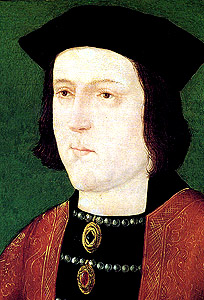
King Edward IV
Edmund Grey, 1st Earl of Kent and 4th Baron Grey de Ruthyn
The Grey family had held the Manor of Wrest in Silsoe since at least 1284. They also held Norwood Manor in Silsoe from 1360. Edmund Grey was born on 26th October 1416. He was son of Sir John Grey and Constance, daughter of John Holand, Duke of Exeter. He fought in part of the Hundred Years War in France and succeeded his grandfather as Lord Grey of Ruthyn on 30th September 1440. He was summoned to parliament the following year. He was a Justice of the Peace in Buckinghamshire from 1447, Bedfordshire from 1448, Northamptonshire from 1448, Huntingdonshire from 1450 and Norfolk from 1485. He attended his first Privy Council meeting on 20th May 1443.
He married Catherine, daughter of Henry Percy, Earl of Northumberland and they had four sons and two daughters; four of their children died in Edmund's lifetime, including his eldest son Anthony, who married a sister of King Edward IV.
He was part of the Lancastrian side in the Wars of the Roses, supporting King Henry VI against first Richard, Duke of York, then his son Edward. This changed on 10th July 1460. The two sides joined battle at Northampton, in the grounds of Delapré Abbey. He commanded the Lancastrian right flank but deserted as the Yorkist forces commanded by the Earl of Warwick approached, ordering his men to lay down their arms so that the Yorkists could reach and pillage the Lancastrian camp, capturing King Henry. Less than a year later Edward was crowned King Edward IV.
Some notes [CRT190/45] based on a history of the family by the 2nd Earl de Grey, written in 1846 stated that he thought the account of his ancestor's actions at Northampton was "based upon the story originated by [John] Dugdale [1628-1700] that de Grey wanted to get hold of Lord Fanhope's lands at Ampthill [John Cornwall, 1st Baron Fanhope and Millbrook who died in 1443]. De Grey and Fanhope being two of the principal leaders on the King's side and that de Grey was promised by the Duke of York, afterwards Edward IV, that if his side, the Yorkists, won the battle, he would give de Grey Lord Fanhope's lands. Dugdale himself only gives the story as a quotation and accepts no responsibility for it. One ground for disbelieving the story is that the [first and] last Lord Fanhope had died without issue seventeen years before. Also there abundant deeds to prove that Sir Edmund bought the Manor of Ampthill from the Executors of Sir Ralph Cromwell in 1446, which Sir Ralph had the property from Lord Fanhope".
Edmund was appointed Lord High Treasurer on 24th June 1463 and on 30th May 1465 was made Earl of Kent, two years after the death of William Nevill, the previous earl. He became Chief Justice of Merioneth in Wales on 28th August 1465. He, his wife and his eldest son and his wife were all members of the Gild of the Holy Trinity in Luton from 1475.
It is interesting that when the supporters of King Henry VI won him back the throne for a short time in 1470 they drew up a bill of attainder against many of Edward IV's chief supporters but the Earl of Kent was not included with these. King Richard III (1483-1485) confirmed de Grey's right to the earldom by calling him to parliament in 1484. He was also confirmed in the title by the usurping King Henry VII (1485-1509) when called to parliament on both 16th October and 18th November 1486, with a grant of £20 per annum. In the grant he is also called Baron and Lord Hastings, Weynsford and Ruthyn, the title Lord Hastings was disputed between the de Grey and Hastings families from 1389 to 1639 when the de Greys finally abandoned their claim. That he survived under Edward IV, Henry VI, Richard III and Henry VII suggests that Edmund de Grey was an astute politician.
He died on 22nd May 1490, aged 73. His wife died in 1492.
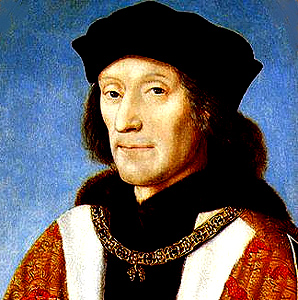
King Henry VII
George Grey, 2nd Earl of Kent and 5th Baron Grey de Ruthyn
He was the second son of the 1st Earl, his elder brother having died in 1480. He was made a Knight of the Bath by King Richard III in July 1483. He was a Justice of the Peace for Huntingdonshire from 1480, for Northamptonshire from 1480 and for Bedfordshire from 1483, for Buckinghamshire from 1494 and for Kent from 1496.
He fought for Henry VII against the Yorkist pretender Perkin Warbeck at the Battle of Stoke Field on 16th June 1487. In 1491 he was a commissioner to raise money in Bedfordshire for a war against France. On 17th June 1497, eleven years and one day after Stoke Field he again fought in a royal army when it defeated Cornish rebels at Deptford Bridge, also known as the Battle of Blackheath.
He married Anne, daughter of Richard Woodville, Earl Rivers, the widow of Henry, Viscount Bourchier, sister of Elizabeth Woodville, queen to Edward IV and had one son by her, his heir Richard. She died on 30th July 1489 and was buried at Old Warden.
The following year he married Catherine, second daughter of William Herbert, Earl of Pembroke. She bore him four sons, including the future 4th Earl of Kent, and one daughter, who was to become grandmother to the 1st Earl of Bedford. Catherine died in November 1506.
George died at Ampthill in December 1505. Earlier that year he had attended court on the visit of King Philip I of Castile (1504-1506) A letter from William Makefyr to Robert D'arcy and Giles Alington of 17th January 1506 reads [CRT190/45]: "The Earl of Kent was mounted on a sorrelled horse, harness of Venice gold with a deep fringe half a yard in length. My Lord of Kent's Coat was one bar of Gold Cloth and another crimson Velvet with a demi-mache cut off by the elbow…a true soldier too, and a favourite of Henry but survived this pageant a very short time, dying within the year".
Richard Grey, 3rd Earl of Kent and 6th Baron Grey of Ruthyn
Richard was the only son of the 2nd Earl of Kent by his first wife Anne, it is not known when he was born but his parents were married from about 1480 until his mother's death in 1489. He was first recorded in 1502 as a commissioner for gaol delivery in Bedfordshire. The following year he married Elizabeth, daughter of Sir William Hussey, Chief Justice of King's Bench. She died in November 1516 and was buried at Warden Abbey.
Richard was a Justice of the Peace in Bedfordshire, Buckinghamshire and Huntingdonshire from 1504. He was a mourner at the funeral of King Henry VII and a sword bearer at the coronation of King Henry VIII (1509-1547). He was Captain of the Army in France in 1513 and 1514.
He attended King Henry VIII at the Field of Cloth of Gold in 1520. He was accompanied by three chaplains, six valets, thirty three servants and twenty horses [CRT190/45].
The Field of the Cloth of Gold was a thoroughly extravagant affair and must have appealed to the earl who seems to have been thoroughly irresponsible with money. Notes taken from a history of the family by the 2nd Earl de Grey [CRT190/45] state: "Richard's inheritance was very considerable. He was already a Knight in his father's lifetime … He wasted the Family property and in the course of his life had mortgaged or sold the bulk of it. There was probably no love lost between himself and Sir Henry, his half-brother and heir. He sold the Manor and Castle of Ruthyn and the Cantred of Dyffrynclwydd as well as the Manor of Ampthill. He also sold the Manor of Ashill in Norfolk to Henry Wyatt and Henlow to William Bohy. He sold his London house to Nicholas Jermyn, citizen and skinner, for the sum of £120. This is described as a great tenement or place with a garden and six cottages adjoining, situated in the parish of Saint Mary Athill in the Ward of Billingsgate".
His second wife was Margaret Waring, a widow who died at some date after 2nd December 1540, wishing to be buried in the church of the Whitefriars in Fleet Street under the tomb of her husband the Earl of Kent.
Richard had no offspring by either wife. He died at nine o'clock at night on 3rd April 1524 at the George Inn, Lombard Street. London.
Henry Grey, 4th Earl of Kent and 7th Baron Grey of Ruthyn
He was the son of the 2nd Earl by his second wife and was born on 23rd April 1490. He never assumed the title of Earl of Kent "because of his slender estate", the family having been impoverished by the lavish spending and gambling of his half-brother the 3rd Earl. He was a Justice of the Peace for Bedfordshire from 1512.
The notes taken from a history of his family by the 2nd Earl de Grey in 1846 [CRT190/45] read: "According to le Neve [Peter le Neve, Norroy King of Arms] Elizabeth, the wife of Thomas, earl of Surrey, the victor of Flodden [a battle against the Scots in 1513], in a letter, says that Henry de Grey fought at Flodden and was taken prisoner by the Scots, but was afterwards exchanged".
"On 28th April 1514 [before becoming Earl] he re-purchased the Manors of Wrest, Flitton, Pulloxhill, Upper Gravenhurst and Lower Gravenhurst, Brobury and Cainhoe with an advowson of Clophill and Hyde from Sir Henry Wyatt, to whom his brother Richard had mortgaged them. In this Deed he describes himself as Henry Grey, but in a Deed dated 20th March 1519 he is described as Sir Henry Grey".
"At his brother Richard's death the estate seems to have been so impoverished that Sir Henry never petitioned the King for the earldom to be conferred to him".
"Amongst other property, he seems to have succeeded to some of the Norfolk estates and also to Blunham, which came in with the Pembroke estates".
In 1542 he received from the King Manors of Gravenhurst and certain lands formerly belonging to Ramsey Abbey, as well as Meppershall, Campton, Over Stondon and Woodhall Grange".
"Amongst the papers at Wrest is a receipt from Mary Tudor [Mary I (1553-1558)] for a loan of £40 from Sir Henry Grey". He was commissioned to raise men from Bedfordshire and Northamptonshire for a war with France in 1544. He died at his house, called Grey Hassetts, at the Barbican in London on 24th September 1562, aged 72 and was buried in London.
Henry married Anne, daughter of John Blennerhassett of Southill. They had a son and three daughters. Their son Henry married Margery, daughter of Sir John Saint John of Bletsoe and died on 20th marc 1545. Their three sons each became Earl of Kent. Anne died between March and May 1565.
Reginald Grey, 5th Earl of Kent and 8th Baron Grey of Ruthyn
He was the eldest grandson of the 4th Earl and was born about 1540. The notes made from a history of the family by the 2nd Earl de Grey in 1846 [CRT190/45] state: "His grandfather, Sir Henry, had nursed the estates so well that, on succeeding Reginald felt in a petition to keep up the dignity of the title and, in consequence [in 1571] petitioned Queen Elizabeth I (1558-1603) that he might use it".
"Having re-established himself, he set to work to try and recover some of the family estates which his uncle Richard had dissipated".
"The arguments on which he based his claim are somewhat involved and difficult to understand, but roughly he seems to have put forward a case that Richard either was not legally entitled to part with the land or, alternatively, that the crown was only holding them in trust for Richard's heirs. However, he seems to have failed in his petition and the lands in question have never been restored to the family".
Reginald was Member of Parliament for Weymouth [Dorset] from 1563 to 1567. He sat on the trial of the Duke of Norfolk for treason in 1572 and, in the same year, was a commissioner investigating the situation with Mary, Queen of Scots, then a prisoner of Elizabeth I in England.
Reginald married Susan, daughter of Richard Bertie and Catherine, Duchess of Norfolk but they had no children. He died at Hornsey [Middlesex] on 17th March 1573 and was buried at Cripplegate.
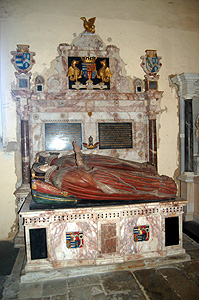
Memorial to the 6th Earl of Kent August 2011
Henry Grey, 6th Earl of Kent and 9th Baron Grey of Ruthyn
Henry was the second son of the 4th Earl and was born in 1541. He was knighted at Carlisle [Cumberland] on 28th August 1570 and took his seat in the House of Lords in 1576. A member of the Queen's Household he was one of the forty commissioners who passed the death sentence on Mary, Queen of Scots in February 1587.
Notes taken from the family history written in 1846 by the 2nd Earl de Grey [CRT190/45] state: "Kent and the earl of Shrewsbury were the two lords commissioned to go to Fotheringhay [Northamptonshire] and break the news to Mary. On being told of the sentence she asked to be allowed to see her Confessor, which request was refused and the Earl of Kent saying to her that "her death would be the life of their religion, as upon the contrary, her life would be the death of it". I am afraid it must be admitted that Kent appears to have had a violent animosity for Mary. He was one of the two Lords Commissioners present at her execution and opposed her request that her own servants might attend her. The Commissioners, however, over-ruled his objection. Up to the very last he appears to have been offensive to her on the score of her religion"
"He seems to have done a considerable amount towards the recovery of the family fortunes and apart from his manors and general estates, at the time of his death, owned four residences namely Wrest, Blunham in Bedfordshire, together with one at Kew in Surrey and the house in the Barbican, London".
It was the 6th Earl who built the first part of the de Grey Mausoleum at Fliton church and is buried there, together with his wife. He married Mary, daughter of Sir George Cotton of Combermere [Cheshire], widow of Edward Stanley, 3rd Earl of Derby. She died on 16th November 1580. The Earl died on 31st January 1615, aged 74 and was buried in his mausoleum on 1st February. He and his wife had no children.
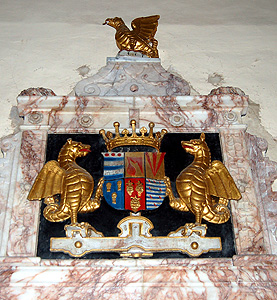
Crest on the memorial to the 6th Earl of Kent August 2011
Charles Grey, 7th Earl of Kent and 10th Baron Grey of Ruthyn
Charles was the third son of the 4th Earl and was born about 1545. When he succeeded to the title on his brother's death he was described as being of Nether Gravenhurst. He had previously been part of the household of Matthew Parker, Archbishop of Canterbury from 1559 to 1575. He became Lord Lieutenant of Bedfordshire on 25th February 1615.
He married Susan, daughter of Sir Richard Cotton of Bedhampton [Hampshire] about 1580. They had two children - a son, who succeeded as the 8th earl and a daughter, Susan, who married Sir Michael Longville of Wolverton [Buckinghamshire] who died in 1617. The 7th Earl died at his manor house of Blunham on 28th September 1623 and was buried in his brother's mausoleum at Flitton.
Henry Grey, 8th Earl of Kent and 11th Baron Grey of Ruthyn
The only son of the 7th Earl, he was born about 1583. He was knighted on 21st April 1603. He became Member of Parliament for Bedfordshire in 1614 and Lord Lieutenant for the county, jointly with his father, from 1621 to 1623 and jointly with the Earl of Cleveland in 1625 and 1626. He took his seat in the House of Lords in February 1624. He was a sword bearer at the coronation of King Charles I (1625-1649).
He married Elizabeth, daughter of Gilbert Talbot, 7th Earl of Shrewsbury on 16th November 1601 at Saint Martin's-in-the-Fields, London. He died on 21st November 1639 at his house in Whitefriars, London and was buried in the de Grey Mausoleum at Flitton. He had no children and the earldom passed to a distant cousin whilst the Barony of Ruthyn passed to his nephew Charles Longville. His widow was said to have then married the well-known intellectual, John Selden and died in December 1651, being buried at Flitton.
Anthony Grey, 9th Earl of Kent.
The 9th Earl was the son of George Grey who was the only son of Anthony Grey of Brancepeth [Durham], the brother of the 4th Earl. The 9th Earl was born at Brancepeth in 1557 and was a clergyman, being Rector of Aston Flamville with Burbage in Leicestershire from 1590 to 1643. He was 82 when he became Earl and, though summoned to parliament in 1640 never took his seat in the House of Lords.
In 1590 he married Magdalen, daughter of William Purefoy of Caldecote [Warwickshire]. They had six sons and five daughters. He died at Burbage on 9th November 1643, aged 86, his widow dying there on 17th April 1653. Both were buried at Burbage.

Memorial of 10th Earl of Kent August 2011
Henry Grey, 10th Earl of Kent
The son of the 9th Earl, he was born on 24th November 1594 at Burbage. He served as Member of Parliament for Leicestershire from 1640 to 1643 and supported Parliament in the civil war against King Charles I.
He was made First Commissioner of the Great Seal of Parliament in November 1643, an office he retained until October 1646 and which he held again from March 1648 to February 1649. He was Speaker of the House of Lords in February 1645 and from September 1647 until February 1649 when the House of Lords was abolished by a vote in the House of Commons.
He was Lord Lieutenant of Rutland from 1644 and for Bedfordshire from 1646. He was a Justice of the Peace for Essex from 1644 until 1645 and in 1647.
He married Mary, daughter of Sir William Courteen, a Dutchman, at Clapham [Surrey] on 14th October 1641. She died in March 1644 and was buried in Westminster Abbey. Her son, born in September 1642 died in June 1644 and was buried with her. The then married a widow, Amabel Fane, on 1st August 1644. She had previously been married to a man named Douce, then widowed. She was the daughter of Sir Anthony Benn, Recorder of London. They had two sons and a daughter together.
The Earl died on 28th May 1651 and was buried in the de Grey Mausoleum at Flitton. Amabel, who had been born in 1607, died on 29th August 1698 and was buried at Flitton. She was known locally as the Good Countess. It is noticeable that on the monument her effigy lies both closer to the viewer and higher than that of her husband, practically obscuring it.
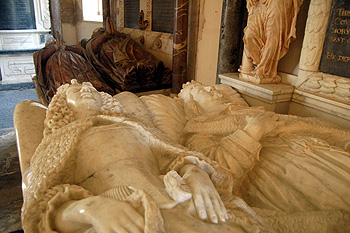
Effigies of the 10th Earl and Countess Amabell August 2011
Anthony Grey, 11th Earl of Kent
He was the second son of the 10th Earl, a half-brother, son of the Earl's first marriage, having died in infancy. He was born on 11th June 1645, three days before the Battle of Naseby, which sealed the success of Parliament over the King in the First Civil War.
He succeeded to the earldom at the age of six and the estate was managed by his mother, who lived for another forty seven years. The notes taken from a history of the family by the 2nd Earl de Grey in 1846 [CRT190/45] state: "She probably had a considerable fortune of her own in addition to the wealth of the de Greys and used it wisely and re-established the position of the family. She seems to have continued to rule at Wrest, even after her son's marriage … and did a certain amount of building and alteration to the estate".
The 11th Earl attended Trinity College, Cambridge and was one of the authors of a series of verses congratulating Charles II (1660-1685) on his restoration to the throne.
He married Mary, daughter and sole heir of John, Lord Lucas of Shenfield, a staunch Royalist during the civil wars, on 2nd March 1663. On 7th May that year she was created 1st Baroness Lucas of Crudwell. Her uncle Charles Lucas had defended Colchester against the Parliamentary Army during the second civil war and was shot for treason on surrendering the town on 28th August 1648. The Earl and Countess had two daughters, both of whom died unmarried, and a son, the future Duke of Kent.
The Earl, perhaps wisely, does not seem to have taken any prominent part on Restoration politics though he was seen as an adherent of the Tory faction which, broadly, espoused Royalism and opposed the disinheritance of King James II (1685-1688) on the grounds of his Roman Catholicism. In this he seems to have followed the beliefs of his wife's family more than those of his own father. Nevertheless he was a pall bearer at the funeral of Queen Mary II (1689-1694), James II's daughter and successor and a sword bearer at the coronation of her sister Queen Anne (1702-1714). This was his last public act as he died suddenly on the bowling green at Tonbridge [Kent] on 9th August 1702. He was buried in the de Grey Mausoleum at Flitton and was quickly joined by his wife who died two months later.
In 1677 he had bought 4 Saint James' Square as the family's London residence. The notes already mentioned [CRT190/45] state: "He was probably the first member of the family to start collecting pictures and other things at Wrest outside those which were definitely family portraits".

Lucas arms in Silsoe church September 2011
Henry Grey, 12th Earl of Kent, 1st Marquess of Kent, 1st Duke of Kent and 2nd Baron Lucas of Crudwell.
See his entry on a separate page.
With the death of the Duke of Kent the titles of Earl, Marquess and Duke of Kent became extinct. In 1799 the fourth son of King George III (1760-1820), Prince Edward Augustus was created Duke of Kent, Duke of Strathearn and Earl of Dublin. He died in 1820 leaving just one daughter as his heir - the future Queen Victoria.
A new Earl of Kent was not created until 1866, for Queen Victoria's second son Alfred Ernest Albert, Duke of Saxe-Coburg-Gotha. He died in 1900, aged 55, a year after his son who died from the affects of a suicide attempt.
The fourth son of King George V (1910-1936) Prince George, was created Duke of Kent, Earl of Saint Andrew's and Baron Downpatrick in 1934. He was killed on 25th August 1942 when the Short Sunderland flying boat in which he was a passenger crashed in Caithness during bad weather. His son Prince Edward the current (2011) Duke succeeded him.